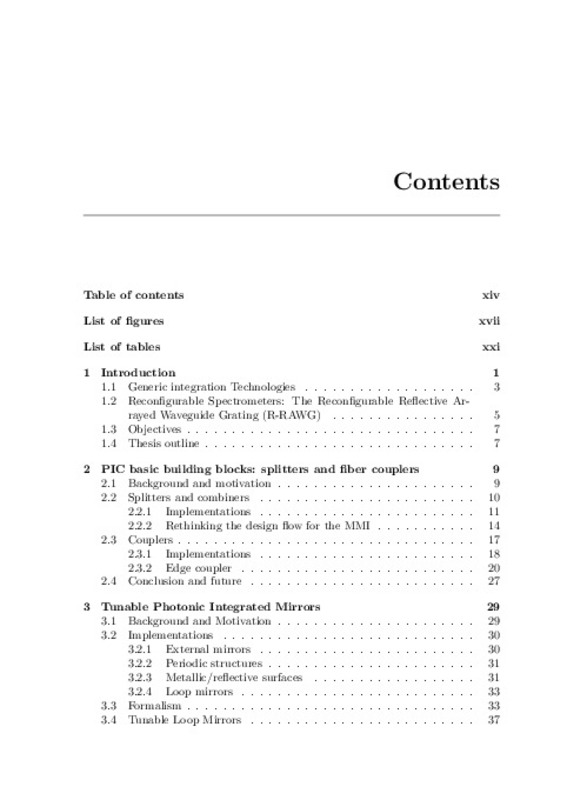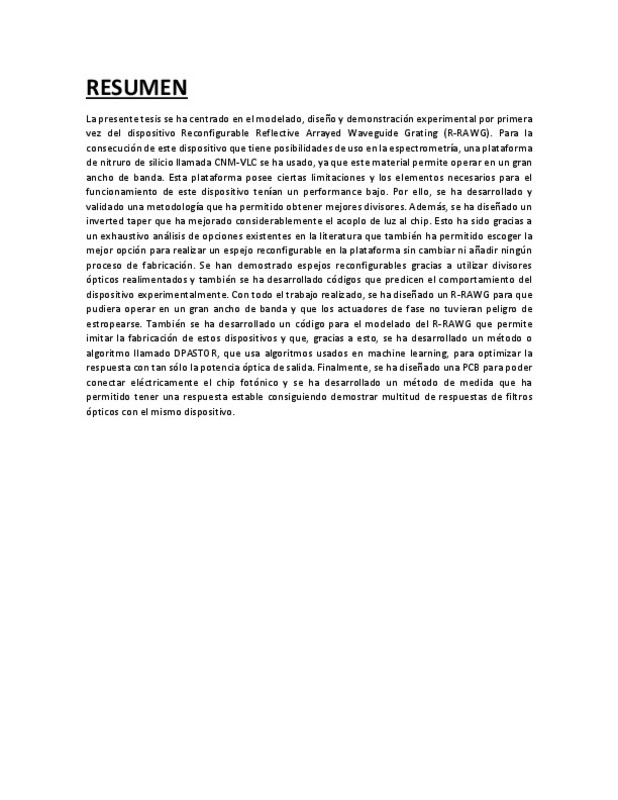- RiuNet repositorio UPV
- :
- Investigación
- :
- Tesis doctorales
- :
- Ver ítem
JavaScript is disabled for your browser. Some features of this site may not work without it.
Buscar en RiuNet
Listar
Mi cuenta
Estadísticas
Ayuda RiuNet
Admin. UPV
Reconfigurable Reflective Arrayed Waveguide Grating on Silicon Nitride
Mostrar el registro sencillo del ítem
Ficheros en el ítem
| dc.contributor.advisor | Muñoz Muñoz, Pascual
|
es_ES |
| dc.contributor.advisor | Doménech Gómez, José David
|
es_ES |
| dc.contributor.author | Fernández Vicente, Juan
|
es_ES |
| dc.date.accessioned | 2021-04-29T12:06:01Z | |
| dc.date.available | 2021-04-29T12:06:01Z | |
| dc.date.created | 2021-03-26 | |
| dc.date.issued | 2021-04-29 | es_ES |
| dc.identifier.uri | http://hdl.handle.net/10251/165783 | |
| dc.description.abstract | [ES] La presente tesis se ha centrado en el modelado, diseño y demonstración experimental por primera vez del dispositivo Reconfigurable Reflective Arrayed Waveguide Grating (R-RAWG). Para la consecución de este dispositivo que tiene posibilidades de uso en la espectrometría, una plataforma de nitruro de silicio llamada CNM-VLC se ha usado, ya que este material permite operar en un gran ancho de banda. Esta plataforma posee ciertas limitaciones y los elementos necesarios para el funcionamiento de este dispositivo tenían un performance bajo. Por ello, se ha desarrollado y validado una metodología que ha permitido obtener mejores divisores. Además, se ha diseñado un inverted taper que ha mejorado considerablemente el acoplo de luz al chip. Esto ha sido gracias a un exhaustivo análisis de opciones existentes en la literatura que también ha permitido escoger la mejor opción para realizar un espejo reconfigurable en la plataforma sin cambiar ni añadir ningún proceso de fabricación. Se han demostrado espejos reconfigurables gracias a utilizar divisores ópticos realimentados y también se ha desarrollado códigos que predicen el comportamiento del dispositivo experimentalmente. Con todo el trabajo realizado, se ha diseñado un R-RAWG para que pudiera operar en un gran ancho de banda y que los actuadores de fase no tuvieran peligro de estropearse. También se ha desarrollado un código para el modelado del R-RAWG que permite imitar la fabricación de estos dispositivos y que, gracias a esto, se ha desarrollado un método o algoritmo llamado DPASTOR, que usa algoritmos usados en machine learning, para optimizar la respuesta con tan sólo la potencia óptica de salida. Finalmente, se ha diseñado una PCB para poder conectar eléctricamente el chip fotónico y se ha desarrollado un método de medida que ha permitido tener una respuesta estable consiguiendo demostrar multitud de respuestas de filtros ópticos con el mismo dispositivo. | es_ES |
| dc.description.abstract | [CAT] La present tesi s'ha centrat en el modelatge, disseny i demonstració experimental per primera vegada del dispositiu Reconfigurable Reflective Arrayed Waveguide Grating (R-RAWG). Per a la consecució d'aquest dispositiu que té possibilitats d'ús en l'espectrometria, una plataforma de nitrur de silici anomenada CNM-VLC s'ha usat ja que aquest material permet operar en una gran amplada de banda. Aquesta plataforma posseeix certes limitacions i els elements necessaris per al funcionament d'aquest dispositiu tenien un performance baix. Per això, s'ha desenvolupat i validat una metodologia que ha permés obtindre millors divisors i també, gràcies als processos de fabricació, s'ha dissenyat un acoplador que ha millorat considerablement l'acoble de llum al xip. Això ha sigut gràcies a un exhaustiu analisis d'opcions existents en la literatura que també ha permés triar la millor opció per a realitzar un espill reconfigurable en la plataforma sense canviar ni afegir cap procés de fabricació. S'han demonstrat espills reconfigurables gràcies a utilitzar divisors realimentats i també s'ha desenvolupat codis que prediuen el comportament del dispostiu experimentalment. Amb tot el treball realitzat, s'ha dissenyat un R-RAWG fent ús de determinades consideracions perquè poguera operar en una gran amplada de banda i que els actuadors de fase no tingueren perill de desbaratar-se. També s'ha desenvolupat un codi per al modelatge del R-RAWG que permet imitar la fabricació d'aquests dispositius i que, gràcies a això, s'ha desenvolupat un mètode o algorisme anomenat DPASTOR, que usa algorismes usats en machine learning, per a optimitzar la resposta amb tan sols la potència òptica d'eixida. Finalment, s'ha dissenyat una PCB per a poder connectar elèctricament el xip fotònic i s'ha desenvolupat un mètode de mesura que ha permés tindre una resposta estable aconseguint demostrar multitud de respostes de filtres òptics amb el mateix dispositiu. | es_ES |
| dc.description.abstract | [EN] This thesis is focused on the modelling, design and experimental demonstration for the first time of Reconfigurable Reflective Arrayed Waveguide Grating (R-RAWG) device. In order to build this device, that can be employed in spectrometry, a silicon nitride platform termed CNM-VLC has been chosen since this material allows to operate in broad range of wavelengths. This platform has the necessary elements, but some limitations because the operation of this device had a low performance. Therefore, a methodology has been developed and validated, which has allowed to obtain better splitters. Also an inverted taper has been designed, which has considerably improved the coupling of light to the chip. This has been possible thanks to an exhaustive analysis of existing options in the literature, that has allowed choosing the best option to make a reconfigurable mirror on the platform without changing or adding new manufacturing steps. Reconfigurable mirrors have been demonstrated by using feedback splitters. Furthermore, codes have been developed to predict the behaviour of the actual device. With all the work done, a R-RAWG has been designed by using certain considerations so that it can operate over a broad wavelength range and the phase actuators are not in danger of being damaged. A code has also been developed for the modelling of the R-RAWG, which allows manufacturing imperfections to be considered, thanks to this, a method or algorithm called DPASTOR has been developed. DPASTOR resembles machine learning to optimise the response by just using the optical output power. Finally, a PCB and an assembly with the chip interconnected to it have been made and designed. Moreover, a measurement method has been developed, which has made it possible to have a stable response and to demonstrate a multitude of optical filter responses with the same device. | es_ES |
| dc.format.extent | 95 | es_ES |
| dc.language | Inglés | es_ES |
| dc.publisher | Universitat Politècnica de València | es_ES |
| dc.rights | Reserva de todos los derechos | es_ES |
| dc.subject | Rejilla de guía de ondas en matriz | es_ES |
| dc.subject | Filtros ópticos reconfigurables | es_ES |
| dc.subject | Algoritmos de optimización | es_ES |
| dc.subject | Multiplexación por división en longitud de onda (WDM) | es_ES |
| dc.subject | Generador de ondas arbitrarias | es_ES |
| dc.subject | Fotónica | es_ES |
| dc.subject | Fotónica integrada | es_ES |
| dc.subject | Nitruro de silicio | es_ES |
| dc.subject | Espectrómetro | es_ES |
| dc.subject | Spectrometer | es_ES |
| dc.subject | Silicon nitride | es_ES |
| dc.subject | Integrated photonics | es_ES |
| dc.subject | R-RAWG | es_ES |
| dc.subject | Photonics | es_ES |
| dc.subject | Arbitrary optical waveform generation | es_ES |
| dc.subject | Wavelength division multiplexing | es_ES |
| dc.subject | Optimization algorithms | es_ES |
| dc.subject | Reconfigurable integrated photonic device | es_ES |
| dc.subject | Reconfigurable optical filters | es_ES |
| dc.subject | Arrayed waveguide grating (AWG) | es_ES |
| dc.subject.classification | TEORIA DE LA SEÑAL Y COMUNICACIONES | es_ES |
| dc.title | Reconfigurable Reflective Arrayed Waveguide Grating on Silicon Nitride | es_ES |
| dc.type | Tesis doctoral | es_ES |
| dc.identifier.doi | 10.4995/Thesis/10251/165783 | es_ES |
| dc.rights.accessRights | Abierto | es_ES |
| dc.contributor.affiliation | Universitat Politècnica de València. Departamento de Comunicaciones - Departament de Comunicacions | es_ES |
| dc.description.bibliographicCitation | Fernández Vicente, J. (2021). Reconfigurable Reflective Arrayed Waveguide Grating on Silicon Nitride [Tesis doctoral]. Universitat Politècnica de València. https://doi.org/10.4995/Thesis/10251/165783 | es_ES |
| dc.description.accrualMethod | TESIS | es_ES |
| dc.type.version | info:eu-repo/semantics/acceptedVersion | es_ES |
| dc.relation.pasarela | TESIS\12361 | es_ES |
Este ítem aparece en la(s) siguiente(s) colección(ones)
-
Tesis doctorales [5389]










